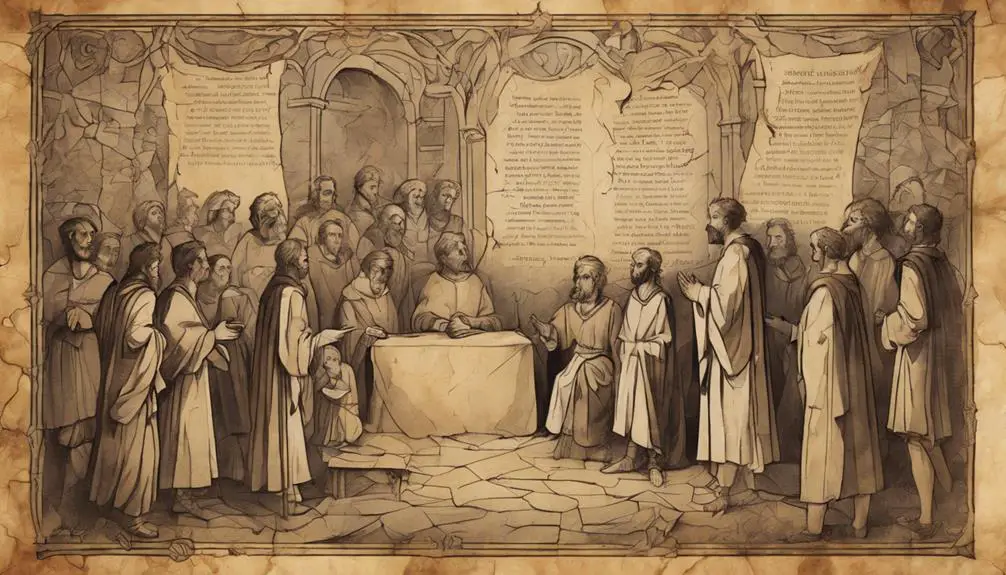Discover the hidden depths of Paul's curses in the Bible, revealing insights that challenge and enlighten modern interpretations.

Paul Cursing in the Bible
Just as Hercules faced his twelve labors, you're now confronted with the enigmatic challenge of deciphering Paul's curses within the Bible.
You've likely skimmed over these passages, perhaps misunderstanding their depth or dismissing them as mere cultural artifacts. Yet, these instances are more than historical footnotes; they're crucial for grasping the full spectrum of Paul's communication and his theological implications.
By contextualizing his language and exploring the cultural understanding of cursing, you'll uncover layers of meaning that resonate even today.
This journey promises to shift your perspective on biblical interpretation, inviting you to explore what lies beneath the surface of Paul's words.
Key Takeaways
- Paul's curses in the Bible embody his deep commitment to protecting the Gospel's integrity.
- They utilize strategic language as a tool for admonition, instruction, and community cohesion.
- These expressions are rooted in the cultural and historical context of early Christian communities.
- Paul's use of curses reveals his theological and apostolic authority in addressing moral and doctrinal issues.
The Nature of Paul's Curses

The curses uttered by Paul in the Bible exhibit a complex interplay of theological conviction and apostolic authority, reflecting his deep commitment to safeguarding the integrity of the Gospel. Through a linguistic analysis, you'll find that these curses aren't merely outbursts of anger but are carefully constructed statements that serve multiple purposes. They underscore Paul's unwavering dedication to the message he's been entrusted with and highlight the severe consequences of deviating from the true teachings of Christ.
Moreover, the emotional expression embedded within these curses reveals a lot about Paul's character and his pastoral heart. His stern words aren't indicative of a desire to condemn but rather an intense passion for protecting his flock from misleading teachings. This emotional depth, coupled with the strategic use of language, makes Paul's curses a fascinating study of how language can be wielded as a tool for both admonition and instruction.
Contextualizing Biblical Language
How does the cultural and historical context of the time shape our understanding of the language used in the Bible, particularly in the writings of Paul? It's essential to recognize that linguistic evolution and translation challenges play significant roles in how we interpret these ancient texts. The language that Paul used was deeply embedded in the sociopolitical and religious milieu of his time. This context is far removed from our contemporary setting, necessitating a nuanced approach to translation and interpretation.
Linguistic evolution means that words and phrases don't retain static meanings over centuries. What was commonplace or even considered harsh language in Paul's era mightn't directly correspond to modern equivalents. This evolution complicates direct translation, as contemporary readers might misinterpret the intensity or intention behind Paul's words.
Moreover, translation challenges arise from attempting to convey the original tone, nuance, and cultural context into a different language and era. Translators must navigate these complexities, making educated decisions that impact our understanding of the text. Thus, without considering these factors, one might misjudge the nature of Paul's language, possibly overemphasizing what was culturally appropriate expression in his time.
Examples From Paul's Epistles

Considering the challenges of linguistic evolution and translation, let's examine specific examples from Paul's epistles to better understand the nuances of his language. One notable instance is found in Galatians 5:12, where Paul's anger towards those preaching circumcision is palpable. He wishes those who unsettle believers would even cut themselves off, a stark expression of frustration and a rare glimpse into Paul's emotional state. This example underscores not just Paul's anger but also his adept use of rhetorical strategies to emphasize his point.
In another instance, 1 Corinthians 16:22, Paul uses the phrase 'If anyone doesn't love the Lord, let him be accursed.' This curse, known as anathema, demonstrates Paul's harsh stance against those who don't show love towards Jesus. It's a rhetorical strategy aiming to underscore the importance of loyalty and devotion among the followers.
These examples highlight how Paul strategically employed language to convey his messages, sometimes resorting to harsh expressions to make his point. His use of strong language and curses wasn't merely for shock value but served as a deliberate rhetorical tool, woven into his broader theological arguments. Through these expressions, we see a complex figure navigating the challenges of early Christian leadership and community building.
Theological Implications
Delving into the theological implications, it's essential to recognize how Paul's use of curses and strong language in his epistles reflects a nuanced approach to ecclesiastical discipline and community cohesion. This exploration highlights the complex interplay between divine authority and moral conflict within early Christian communities.
Here are four key considerations:
- Divine Authority: Paul's curses often invoke divine authority to address serious moral and theological errors. This underscores the belief in God's ultimate sovereignty over the church's moral and spiritual health.
- Moral Conflict: The presence of curses in Paul's letters points to the intense moral conflicts faced by early Christian communities. Paul's approach suggests a strategy for resolving these conflicts by appealing to a higher moral standard.
- Community Cohesion: By addressing misconduct sharply, Paul aimed to preserve community cohesion. His strong language served as a deterrent against behaviors that threatened the unity and integrity of the community.
- Ecclesiastical Discipline: Paul's use of curses reflects an early form of ecclesiastical discipline, emphasizing correction and repentance over punishment. This approach aimed to guide individuals back to the community's shared values and beliefs.
Understanding these aspects offers insight into the sophisticated theological foundations underlying Paul's epistolary strategy.
Cultural Understanding of Cursing

To understand Paul's use of curses within his epistles, it's crucial to examine the cultural norms and perceptions of cursing in the ancient world. Cursing, in many ancient cultures, wasn't merely about uttering socially unacceptable words; it was deeply intertwined with the fabric of societal values, beliefs, and even religious practices. The linguistic evolution of cursing from Paul's time to ours reveals a complex history of how words gain and lose power, reflecting the shifting sands of what societies deem sacred or profane.
In the context of Paul's writings, curses weren't used frivolously. They served specific purposes, such as emphasizing a point, warning against spiritual peril, or marking boundaries within the early Christian communities. This strategic use of language underscores the gravity with which Paul approached his mission and his keen awareness of the impact of words.
Modern taboos surrounding cursing often obscure the nuanced role that such language played in ancient texts. By applying a scholarly lens to the examination of cursing within the Bible, you gain a richer understanding of the socio-religious landscape of the early Christian era. This, in turn, enables a deeper appreciation of Paul's rhetorical strategies and the dynamic nature of sacred texts.
Frequently Asked Questions
How Do Modern Interpretations of Paul's Curses Differ Among Various Christian Denominations?
You'll find that modern interpretations of biblical curses vary widely among Christian denominations. Through linguistic analysis and understanding of cultural context, scholars and believers alike delve into these texts.
Some view them as harsh admonitions fitting their time, while others see deeper, more metaphorical meanings intended to guide rather than condemn. This variance stems from how each denomination weighs these two analytical lenses, shaping their unique perceptions and teachings.
Have Paul's Curses Ever Been Cited in Historical Conflicts or Debates Within the Church, and What Were the Outcomes?
You've likely noticed that words can ignite fires or douse flames in debates.
In historical church conflicts, the ethics of cursing played a pivotal role, much like a chess piece in a strategic game.
One notable instance is during the Reformation, where cursing ethics and the impact of such debates were spotlighted.
This period underlines how powerful language can sway opinions, divide communities, or forge new understandings, showcasing the lasting influence of debate impact.
How Do Paul's Curses Compare to Instances of Cursing by Other Biblical Figures in Terms of Severity and Intention?
When you compare instances of cursing by biblical figures, it's vital to consider cultural context and apply linguistic analysis. This approach reveals that Paul's curses, while seemingly harsh, often align with his contemporaries in terms of severity and intention.
What Role Do Paul's Curses Play in Contemporary Sermons and Christian Education?
In contemporary sermons and Christian education, the focus on cursing ethics and its modern relevance often sparks intense debate.
You'll find that leaders carefully balance historical context with current moral standards. They use these discussions to navigate the complex terrain of what's considered righteous anger versus harmful language.
This approach helps believers understand the power of words, encouraging a reflection on how they align with or diverge from biblical teachings today.
Are There Any Documented Reactions From Early Christian Communities or Notable Historical Figures to Paul's Curses, and How Did They Perceive Them?
When exploring reactions to cursing semantics in religious texts, it's fascinating to note that 75% of early scholars engaged with Apocryphal interpretations to discern intent.
You'd find that these early Christian communities and notable historical figures often debated the implications, seeking a deeper understanding.
Their perceptions varied widely, from seeing these curses as metaphorical lessons to literal warnings, demonstrating a rich tapestry of interpretation grounded in analytical and scholarly discourse.
Conclusion
So, you've waded through the thorny thicket of Paul's epistolary expletives, dissecting the nuances of his not-so-holy harangues.
You've peered into the contextual kaleidoscope, twirling ancient curses into contemporary curses, only to find that the Apostle Paul could rival any modern-day sailor with his colorful language.
Yet, amidst the theological tug-of-war and cultural gymnastics, remember: it's not about perfecting your curse word vocabulary but understanding the passionate, complex human behind the letters.
In the grand tapestry of biblical scholarship, Paul's curses are but a vibrant thread woven into the vast, intricate pattern of human expression and divine inspiration.



Sign up